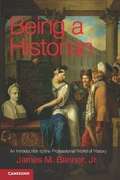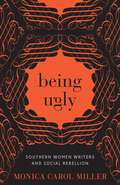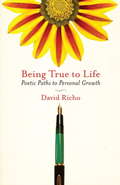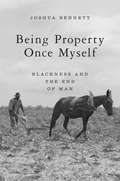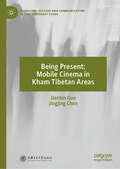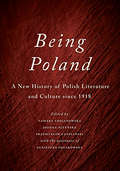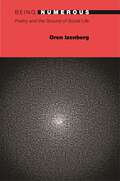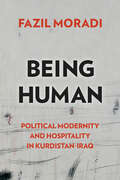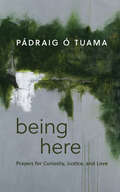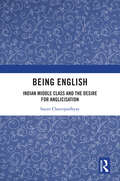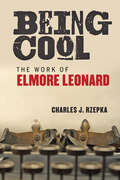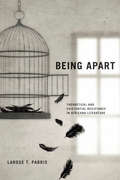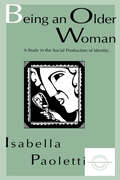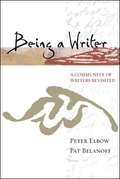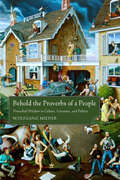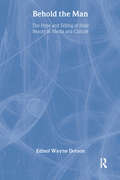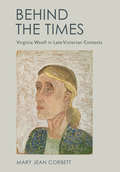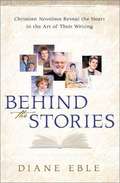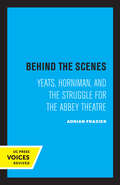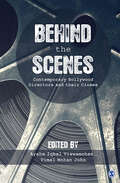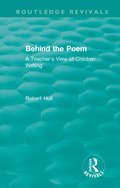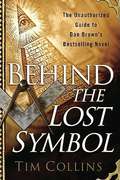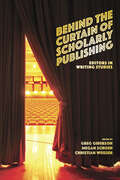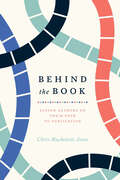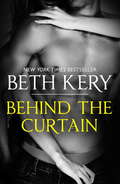- Table View
- List View
Being a Historian: An Introduction to the Professional World of History
by James M. Banner Jr.Considers what aspiring and mature historians need to know about the discipline of history in the United States today.
Being Ugly: Southern Women Writers and Social Rebellion (Southern Literary Studies)
by Monica Carol MillerIn the South, one notion of “being ugly” implies inappropriate or coarse behavior that transgresses social norms of courtesy. While popular stereotypes of the region often highlight southern belles as the epitome of feminine power, women writers from the South frequently stray from this convention and invest their fiction with female protagonists described as ugly or chastised for behaving that way. Through this divergence, “ugly” can be a force for challenging the strictures of normative southern gender roles and marriage economies. In Being Ugly: Southern Women Writers and Social Rebellion, Monica Carol Miller reveals how authors from Margaret Mitchell to Monique Truong employ “ugly” characters to upend the expectations of patriarchy and open up more possibilities for southern female identity. Previous scholarship often conflates ugliness with such categories as the grotesque, plain, or abject, but Miller disassociates these negative descriptors from a group of characters created by southern women writers. Focusing on how such characters appear prone to rebellious and socially inappropriate behavior, Miller argues that ugliness subverts assumptions about gender by identifying those who are unsuitable for the expected roles of marriage and motherhood. As opposed to familiar courtship and marriage plots, Miller locates in fiction by southern women writers an alternative genealogy, the ugly plot. This narrative tradition highlights female characters whose rebellion offers a space for re-imagining alternative lives and households in opposition to the status quo. Reading works by canonical writers like Zora Neale Hurston, Flannery O’Connor, and Eudora Welty, along with recent texts by contemporary authors like Helen Ellis, Lee Smith, and Jesmyn Ward, Being Ugly offers an important new perspective on how southern women writers confront regressive ideologies that insist upon limited roles for women.
Being True to Life: Poetic Paths to Personal Growth
by David RichoPsychotherapist David Richo offers a fresh and inspiring approach to personal growth: we can use the process of writing and reading poetry to move toward greater self-understanding and emotional healing. Even if you've never written a poem before, you can learn to use poetry to explore your feelings, your relationships, your childhood, your dreams, and more.Richo explains how the creative, intuitive process of making poetry can help us gain access to our deepest truths, leading us to make connections and explore experiences in a new way, beyond the constraints of everyday language. This book offers a range of practical exercises for getting started, as well as guidance on how to read poetry in a way that can be personally transformative.Being True to Life shows us that poetry is not reserved for a few specially talented individuals but is a deeply human activity that anyone can tap into for greater clarity and insight into life's struggles, beauty, and mysteries.
Being Property Once Myself: Blackness and the End of Man
by Joshua BennettA prize-winning poet argues that blackness acts as the caesura between human and nonhuman, man and animal. Throughout US history, black people have been configured as sociolegal nonpersons, a subgenre of the human. Being Property Once Myself delves into the literary imagination and ethical concerns that have emerged from this experience. Each chapter tracks a specific animal figure—the rat, the cock, the mule, the dog, and the shark—in the works of black authors such as Richard Wright, Toni Morrison, Zora Neale Hurston, Jesmyn Ward, and Robert Hayden. The plantation, the wilderness, the kitchenette overrun with pests, the simultaneous valuation and sale of animals and enslaved people—all are sites made unforgettable by literature in which we find black and animal life in fraught proximity. Joshua Bennett argues that animal figures are deployed in these texts to assert a theory of black sociality and to combat dominant claims about the limits of personhood. Bennett also turns to the black radical tradition to challenge the pervasiveness of antiblackness in discourses surrounding the environment and animals. Being Property Once Myself is an incisive work of literary criticism and a close reading of undertheorized notions of dehumanization and the Anthropocene.
Being Present: Mobile Cinema in Kham Tibetan Areas (Pluralism, Culture and Communication in Contemporary China)
by Jianbin Guo Jingjing ChenThis book presents the restoration of rural mobile cinema network in the Great Triangle region at the conjunction of Yunnan, Sichuan, and Tibet in China in the new century, which has added a new chapter to the long-standing complex relationship between cinema and social change. Based on five years of multi-sited fieldwork, abundant interviews and oral history narratives, this work shows the entanglement of the State, the projectionists and local film viewers in the historical and social context in a holistic analytic framework. By using the key concept of “being present” to examine the tangling relations between the actors in mobile cinema as social practice, the work argues that mobile cinema and contemporary Chinese society are mutually constructed in both textual and practical level.
Being Poland: A New History of Polish Literature and Culture since 1918
by Tamara Trojanowska Joanna Nizynska Przemyslaw Czaplinski Agnieszka PolakowskaBeing Poland offers a unique analysis of the cultural developments that took place in Poland after World War One, a period marked by Poland’s return to independence. Conceived to address the lack of critical scholarship on Poland’s cultural restoration, Being Poland illuminates the continuities, paradoxes, and contradictions of Poland’s modern and contemporary cultural practices, and challenges the narrative typically prescribed to Polish literature and film. Reflecting the radical changes, rifts, and restorations that swept through Poland in this period, Polish literature and film reveal a multitude of perspectives. Addressing romantic perceptions of the Polish immigrant, the politics of post-war cinema, poetry, and mass media, Being Poland is a comprehensive reference work written with the intention of exposing an international audience to the explosion of Polish literature and film that emerged in the twentieth century.
Being Numerous: Poetry and the Ground of Social Life (20/21 #11)
by Oren Izenberg"Because I am not silent," George Oppen wrote, "the poems are bad." What does it mean for the goodness of an art to depend upon its disappearance? In Being Numerous, Oren Izenberg offers a new way to understand the divisions that organize twentieth-century poetry. He argues that the most important conflict is not between styles or aesthetic politics, but between poets who seek to preserve or produce the incommensurable particularity of experience by making powerful objects, and poets whose radical commitment to abstract personhood seems altogether incompatible with experience--and with poems. Reading across the apparent gulf that separates traditional and avant-garde poets, Izenberg reveals the common philosophical urgency that lies behind diverse forms of poetic difficulty--from Yeats's esoteric symbolism and Oppen's minimalism and silence to O'Hara's joyful slightness and the Language poets' rejection of traditional aesthetic satisfactions. For these poets, what begins as a practical question about the conduct of literary life--what distinguishes a poet or group of poets?--ends up as an ontological inquiry about social life: What is a person and how is a community possible? In the face of the violence and dislocation of the twentieth century, these poets resist their will to mastery, shy away from the sensual richness of their strongest work, and undermine the particularity of their imaginative and moral visions--all in an effort to allow personhood itself to emerge as an undeniable fact making an unrefusable claim.
Being Human: Political Modernity and Hospitality in Kurdistan-Iraq (Genocide, Political Violence, Human Rights)
by Fazil MoradiThe Iraqi Baʿth state’s Anfāl operations (1987-1991) is one of the twentieth century’s ultimate acts of destruction of the possibility of being human. It remains the first and only crime of state in the Middle East to be tried under the 1948 UN Genocide Convention, the 1950 Nuremberg Principles, and the 1969 Iraqi Penal Code and to be recognized as genocide, crimes against humanity, and war crimes in Baghdad between 2006 and 2007. Being Human: Political Modernity and Hospitality in Kurdistan-Iraq offers an unprecedented pathway to the study of political violence. It is a sweeping work of anthropological hospitality, returning to the Anfāl operations as the violence of political modernity only to turn to the human survivors’ hospitality and acts of translation—testimonial narratives, law, politics, archive, poetry, artworks, museums, memorials, symbolic cemeteries, and infinite pursuit of justice in the Kurdistan Region of Iraq. Being Human gathers together social sciences, humanities, and the arts to understand modernity's violence and its living on.
Being Here: Prayers for Curiosity, Justice, and Love
by Pádraig Ó Tuama&“What is prayer? It&’s not a passport to heaven. If anything, it&’s a way of seeing here, a way of being here.&” In Being Here, acclaimed poet and theologian Pádraig Ó Tuama offers a thoughtful collection of prayers and essays to focus attention in a world full of distractions. Featuring 31 collects—an ancient five-fold form of prayer—this unconventional devotional invites readers into a daily rhythm of connection and creativity. &“The hope is that you can turn to a prayer with the story of your life, and in the little emptiness you create there, hear something, discern something, feel something that&’s connecting you to other things seeking out connection with you.&” Each day&’s prayers are presented alongside scripture and illuminating literary texts. The book concludes with four incisive essays on politics, community, and the contours of contemporary life as seen through biblical literature. Pádraig also teaches readers how they can embrace poetic form to expand their practice of prayer. In these pages, spiritual wayfarers will find a place to both rest and grow their capacity for curiosity, justice, and love. This is a way of living / That&’s worth living daily.
Being English: Indian Middle Class and the Desire for Anglicisation
by Sayan ChattopadhyayThis book critically examines the cultural desire for anglicisation of the Indian middle class in the context of postcolonial India. It looks at the history of anglicised self-fashioning as one of the major responses of the Indian middle class to British colonialism. The book explores the rich variety of nineteenth- and twentieth-century writings that document the attempts by the Indian middle class to innovatively interpret their personal histories, their putative racial histories, and the history of India to appropriate the English language and lay claim to an “English” identity. It discusses this unique quest for “Englishness” by reading the works of authors like Michael Madhusudan Dutt, Rabindranath Tagore, Cornelia Sorabji, Nirad C. Chaudhuri, Dom Moraes, and Salman Rushdie. An important intervention, this book will be of interest to scholars and researchers of postcolonial studies, Indian English literature, South Asian studies, cultural studies, and English literature in general.
Being Cool: The Work of Elmore Leonard
by Charles J. RzepkaAn in-depth look into the life and work of the man who defined "cool" for crime fiction, Elmore Leonard.Widely known as the crime fiction writer whose work led to the movies Get Shorty and Out of Sight, Elmore Leonard had a special knack for creating "cool" characters. In Being Cool, Charles J. Rzepka looks at what makes the dope-dealers, bookies, grifters, financial advisors, talent agents, shady attorneys, hookers, models, and crooked cops of Leonard's world cool. They may be nefarious, but they are also confident, skilled, and composed. And they are good at what they do. Taking being cool as the highway through Leonard's life and works, Rzepka finds plenty of byways to explore along the way.Rzepka delineates the stages and patterns that characterize Leonard’s creative evolution. Like jazz greats, he forged an individual writing style immediately recognizable for its voice and rhythm, including his characters' rat-a-tat recitations, curt backhands, and ragged trains of thought. Rzepka draws on more than twelve hours of personal interviews with Leonard and applies what he learned to his close analysis of the writer’s long life and prodigious output: 45 published novels, 39 published and unpublished short stories, and numerous essays written over the course of six decades.
Being Apart: Theoretical and Existential Resistance in Africana Literature
by Larose T. ParrisIn Being Apart, LaRose Parris draws on traditional and radical Western theory to emphasize how nineteenth- and twentieth-century Africana thinkers explored the two principal existential themes of being and freedom prior to existentialism's rise to prominence in postwar European thought. Emphasizing diasporic connections among the works of authors from the United States, the Caribbean, and the African continent, Parris argues that writers such as David Walker, Frederick Douglass, W. E. B. Du Bois, C. L. R. James, Frantz Fanon, and Kamau Brathwaite refute what she has termed the tripartite crux of Western canonical discourse: the erasure of ancient Africa from the narrative of Western civilization, the dehumanization of the African and the creation of the Negro slave, and the denial of chattel slavery's role in the growth of Western capitalism and empire. These writers' ontological and phenomenological ruminations not only challenge the assigned historical and epistemological marginality of Africana people but also defy current canonical demarcations. Charting the rise of Eurocentrism through a genealogy of eighteenth-century Enlightenment racial science while foregrounding the lived Africana experience of racism in the late nineteenth and twentieth centuries, Parris shows that racist ideology is intrinsic to modern Western thought rather than being an ideological aberration.
Being An Older Woman: A Study in the Social Production of Identity (Everyday Communication Series)
by Isabella PaolettiThe study presented in this volume examines how older women's identities are socially constructed and, in particular, how they can be influenced by institutional intervention. The interest in identity production is not only theoretical, but also practical. Different perceptions of oneself as an older woman involve considerable differences in the definition of that person's possible sphere of action, and therefore, in her life perspectives. The data -- collected during a four-year project studying older women -- consist of video recordings of the committee meetings of the Older Women's Group of Perugia, Italy. Other video recordings of theater workshops and of the management committee meetings of the Senior Citizen Centers in Perugia are used as a source of comparison. Transcripts of the video material are analyzed through a detailed discourse analysis within an ethnomethodological framework. The data are used to explore how gender and age identities are interactionally constructed in specific institutional contexts. The first part of the book focuses on the interactional construction of aging. It shows how "being old" is constructed conversationally, in particular, through the use of membership categories. Distancing from the category "old" and denial of aging are frequently encountered conversational moves. However, the category is perceived as acceptable, even desired and invoked, when it becomes an institutionally relevant category, giving access to interesting activities or special benefits. The second part of the book explores gender identification. Conflict among different institutional subjects is shown to fade into gender conflict. The study analyzes how institutional interventions exert a powerful influence on older women's identities, giving them new opportunities for action. It also looks at how the conversational styles, attitudes, and activities of specific women influence the features of those very institutions. In short, this book describes the discourse and social practices that constitute older women's identities -- helping to identify and deconstruct stereotypes that tend to produce marginalization of older people. The book's existence is itself a contribution to the construction of older women as busy, lively, appealing human beings; it is the first research publication to emerge from The European Older Women's Project. Of interest to those in any discipline studying the topics of ethnomethodology, gender, aging, and identity.
Being A Writer: A Community of Writers Revisited
by Peter Elbow Patricia BelanoffBeing A Writer is a brief rhetoric that explores writing processes with an emphasis on their variety; invention, with an emphasis on its playfulness; revision as a technique of invention; collaboration as a means of revision; and personal engagement in academic writing, from literary analysis to argument.
Behold the Proverbs of a People: Proverbial Wisdom in Culture, Literature, and Politics
by Wolfgang MiederThe thirteen chapters of this book comprise an intriguing and informative entry into the world of proverb scholarship, illustrating that proverbs have always been and continue to be wisdom's international currency. The first section of the book focuses on the field of paremiology (proverb studies) in general, the spread of Anglo-American proverbs in Europe, and the phenomenon of modern proverbs. The second section analyzes the use of proverbs in the world of politics, including a chapter on President Obama, while the third concentrates on the uses of proverbs in literature. The final section ends with detailed cultural studies of the origin, history, dissemination, use, function, and meaning of specific proverbs.Noted scholar Wolfgang Mieder shows that proverbs matter in culture, literature, and politics. Proverbs remain part and parcel of oral and written communication, and, he demonstrates, they deserve to be studied from a range of viewpoints. While various chapters deal with a variety of issues and approaches, they cohere through a rhetorical perspective that looks at the text, texture, and context of proverbs as speech acts that make a noteworthy impact on culture and society. Whether proverbs appear in everyday speech, on the radio, on television, in films, on the pages of newspapers or magazines, in advertisements, in literary works, or in political speeches, they serve as formulaic verbal devices to add authoritative weight through tradition, convention, and wisdom.
Behold the Man: The Hype and Selling of Male Beauty in Media and Culture
by Edisol DotsonThe first comprehensive study of how images of male beauty are projected onto society, Behold the Man: The Hype and Selling of Male Beauty in Media and Culture examines the role media and society play in creating the image of the idealized male. This book explores how these images are interpreted by all genders and sexual orientations in order to investigate the phenomenon’s effect on the self-esteem of adolescent and adult males. Behold the Man provides you with research and examples that identify this problem from many angles to help you realize that being a man is more than merely possessing muscles and good looks.Discussing examples in which both attractive men and women are idealized as “the norm,” Behold the Man argues that men are experiencing the same injustices as women--splashed on the covers of magazines and in advertisements, based on their sex appeal, sometimes to promote nothing more than their looks. Within Behold the Man, you‘ll find topics that relate to the reasons for and effects of male beauty standards, such as: aspects of male beauty, from Ancient Greek ideals to how it is visualized throughout history in art the vision of “the ideal male,” along with sexual connotations, in advertisements for clothing, cologne, sunglasses, automobiles, and shaving products the emphasis of strong, well-built males and their bodies in movies, music videos, and literature how men alter their bodies by dieting and cosmetic surgery to achieve the look found in advertisements today’s growing numbers of male eating disorders caused by the notion that only good-looking, muscular men are acceptable reasons behind the exploitation of the male body and the double standards for male beauty found within gay male communities how advertisers and authors faithfully follow the “bigger is better” theory--from pectoral and bicep muscles to penis sizeRecognizing how society has created and changed the appearance of the ideal male, this text explains to you the danger men of all ages face who feel they need to be physically handsome to be desirable. From Behold the Man, you’ll learn about the real messages of advertising and media, the problems they cause, and that true self-worth cannot be measured by physical attributes.
Behind the Times: Virginia Woolf in Late-Victorian Contexts
by Mary Jean CorbettVirginia Woolf, throughout her career as a novelist and critic, deliberately framed herself as a modern writer invested in literary tradition but not bound to its conventions; engaged with politics but not a propagandist; a woman of letters but not a "lady novelist." As a result, Woolf ignored or disparaged most of the women writers of her parents' generation, leading feminist critics to position her primarily as a forward-thinking modernist who rejected a stultifying Victorian past. In Behind the Times, Mary Jean Corbett finds that Woolf did not dismiss this history as much as she boldly rewrote it.Exploring the connections between Woolf's immediate and extended family and the broader contexts of late-Victorian literary and political culture, Corbett emphasizes the ongoing significance of the previous generation's concerns and controversies to Woolf's considerable achievements. Behind the Times rereads and revises Woolf's creative works, politics, and criticism in relation to women writers including the New Woman novelist Sarah Grand, the novelist and playwright, Lucy Clifford; the novelist and anti-suffragist, Mary Augusta Ward. It explores Woolf's attitudes to late-Victorian women's philanthropy, the social purity movement, and women's suffrage. Closely tracking the ways in which Woolf both followed and departed from these predecessors, Corbett complicates Woolf's identity as a modernist, her navigation of the literary marketplace, her ambivalence about literary professionalism and the mixing of art and politics, and the emergence of feminism as a persistent concern of her work.
Behind the Stories: Christian Novelists Reveal the Heart in the Art of Their Writing
by Diane EbleAs editor of the "PageTurner's Journal," Diane Eble has interviewed all the top fiction authors in the Christian market. Now, in "Behind the Stories," she shares inspiring personal conversations with each author. This memoir includes photos and never-before-published thoughts and interests of many of the best Christian novelists of today.
Behind the Scenes: Yeats, Horniman, and the Struggle for the Abbey Theatre (The New Historicism: Studies in Cultural Poetics #11)
by Adrian FrazierBehind the Scenes presents the story of Dublin's famous Abbey Theatre and its major creative personalities: W. B. Yeats, Annie Horniman, J. M. Synge, and Lady Gregory. Part history, part sociology, part biography, Frazier's work recreates the forces that shaped the Abbey stage, forces that involved the spirited participation of actors, audiences, press, and financiers as well as of the famous poet-playwright who was its co-director. His book unfolds an entertaining and suspenseful tale, centered on the undeniably autocratic personality of W.B. Yeats and with the political struggles of Ireland as a backdrop. This title is part of UC Press's Voices Revived program, which commemorates University of California Press's mission to seek out and cultivate the brightest minds and give them voice, reach, and impact. Drawing on a backlist dating to 1893, Voices Revived makes high-quality, peer-reviewed scholarship accessible once again using print-on-demand technology. This title was originally published in 1990.
Behind the Scenes: Contemporary Bollywood Directors and Their Cinema
by Aysha Iqbal Viswamohan and Vimal Mohan JohnFor those who think, read, teach, and write about Bollywood, this book is the release of the year! They are the ‘stars’ who sit behind the camera and create magic between ‘Action’ and ‘Cut’. Meet the directors of New Age cinema who with their themes, characteristic styles, and masterful storytelling are bridging the gap between commerce and content, commercial and art-house cinema. This book introduces you to the films they have made and provides a critical analysis of their craft, while remaining grounded in cinematic and popular culture theories. It shows the distinct ways in which they have handled issues of gender, urban culture, and social inequality.
Behind the Poem: A Teacher's View of Children Writing (Routledge Revivals)
by Robert HullPublished in 1988, this book is a teacher’s eye view of how children come to write and rewrite poems, and of how they make aesthetic choices in their writing. Drawing on over twenty years’ experience of teaching poetry in primary and secondary schools, Robert Hull presents a detailed account of the process of writing poetry in the classroom. The reader is invited, almost in confidence, to be witness to a skilled teacher’s planning, recognition, and definition of children’s emergent understanding and expertise. The author adopts a non-behaviourist model which stresses difficulty and uncertainty, rejecting a simplistic assumption of linear progression, predictability of outcome, and short-term results. The many examples of poems written by the children demonstrate in a very vivid and impressive way the value of this approach. All teachers, not just of poetry, will find this a fascinating and informed study, and an inspiration for their own work in the classroom.
Behind the Lost Symbol: The Unauthorized Guide to Dan Brown's Bestselling Novel
by Tim CollinsTHE SYMBOL WAS LOST... BUT THE TRUTH HAS BEEN FOUND!<P> With his blockbuster bestselling novels The Da Vinci Code and Angels and Demons, author Dan Brown introduced readers to a world of symbols and secret societies, men of God warring with men of Science, and the adventures of brilliant Harvard symbologist Robert Langdon. Now, with his newest novel, The Lost Symbol, Brown has woven a complex web of intrigue, religion, technology, and great historical figures guiding the destiny of mankind.<P> Inside this book, you will find the truth behind The Lost Symbol's history and myths, such as:<P> * The strength and influence of the enigmatic Freemasons throughout history <P> * The founding fathers of the United States--and their possible connections with secret organizations such as the Illuminati and the Templars <P> * The meaning within the symbols of the Great Seal of the United States <P> * The identity of the Masonic "Great Architect of the Universe" <P> * And so much more! <P> For armchair historians and devoted fans-or those who want to know where the line is drawn between fact and fiction-this is the ultimate guide to the mysteries, symbolism, and historical contexts of Dan Brown's thrilling novel.
Behind the Curtain of Scholarly Publishing: Editors in Writing Studies
by Greg Giberson Megan Schoen Christian WeisserUntil now there has been little consideration of the intellectual and historical impact editors have had on the young and ever-evolving field of writing studies. Behind the Curtain of Scholarly Publishing provides new and seasoned scholars with behind-the-scenes explorations and expositions of the history of scholarly editing and the role of the scholarly editor from the perspectives of current and former editors from important publications within the field. Each chapter in the collection examines the unique experiences and individual contributions of its authors during their time as editors, offering advice to scholars and potential editors on how to navigate the publication process and understand editorial roles. The contributors provide multiple perspectives on the growth, transformation, and, in some cases, founding of some of the most influential publishing venues in writing studies. The personal and historical narratives, along with the unique perspectives and insightful analyses of the individual authors in Behind the Curtain of Scholarly Publishing, offer needed transparency and context to what has historically been an opaque, yet inevitable and consequential, part of academic life. This volume will help researchers in the field understand the publishing process. Contributors: Cheryl Ball, David Bartholomae, Charles Bazerman, Jean Ferguson Carr, Douglas Eyman, Muriel Harris, Byron Hawk, Alice Horning, Paul Kei Matsuda, Laura Micciche, Mike Palmquist, Michael Pemberton, Malea Powell, Kelly Ritter, Victor Villanueva, Victor Vitanza, Kathleen Blake Yancey
Behind the Book: Eleven Authors on Their Path to Publication (Chicago Guides to Writing, Editing, and Publishing)
by Chris Mackenzie JonesEvery book has a story of its own, a path leading from the initial idea that sparked it to its emergence into the world in published form. No two books follow quite the same path, but all are shaped by a similar array of market forces and writing craft concerns as well as by a cast of characters stretching beyond the author. Behind the Book explores how eleven contemporary first-time authors, in genres ranging from post-apocalyptic fiction to young adult fantasy to travel memoir, navigated these pathways with their debut works. Based on extensive interviews with the authors, it covers the process of writing and publishing a book from beginning to end, including idea generation, developing a process, building a support network, revising the manuscript, finding the right approach to publication, building awareness, and ultimately moving on to the next project. It also includes insights from editors, agents, publishers, and others who helped to bring these projects to life. Unlike other books on writing craft, Behind the Book looks at the larger picture of how an author’s work and choices can affect the outcome of a project. The authors profiled in each story open up about their challenges, mistakes, and successes. While their paths to publication may be unique, together they offer important lessons that authors of all types can apply to their own writing journeys.
Behind The Curtain
by Beth KeryFrom the New York Times bestselling author of Because You Are Mine, The Affair and Make Me - Behind the Curtain is a seductive standalone romance, perfect for fans of E. L. James, Sylvia Day, Jodi Ellen Malpas and J. Kenner, that will have you begging for more...There's something about this woman that could bring a man to his knees...On a break between overseas jobs, journalist Asher Gaites returns to his hometown of Chicago - and allows his friends to persuade him to check out a hot new singer. At a downtown jazz club, he's soon transfixed by the lyrical voice and sensuous body of a woman who performs behind a thin, shimmering veil...The veil gives Moroccan-American Laila Barek the anonymity she needs, since she has never been able to reconcile her family's values with her passion for music. But one man is inexplicably drawn to her. And when Asher confronts her on a subway platform after a gig, he's shocked to recognize the woman who walked away from him eight years ago...Laila has never been able to forget the touch, the feel, the taste of Asher. And despite the doubt and fear that wind their way into their lives, they must trust the heat of their desire to burn down the walls the world has placed between them...Discover the other captivating titles by Beth Kery: Looking Inside, Make Me, The Affair, the One Night of Passion series, and her bestselling erotically charged series which began with Because You Are Mine.
